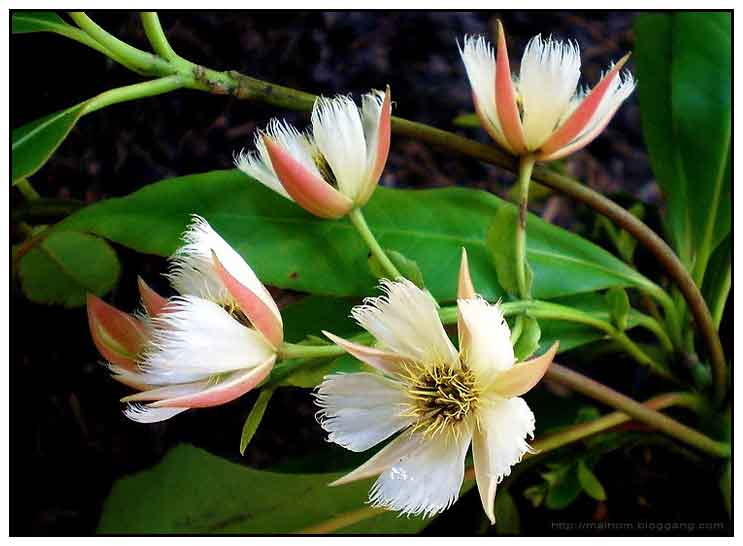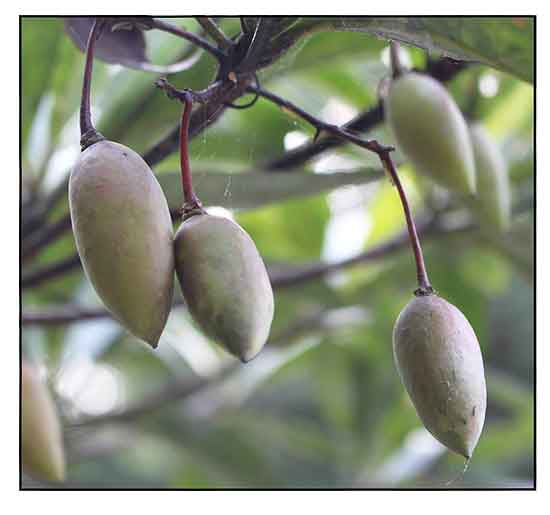
Family • Elaeocarpaceae
Mala
Elaeocarpus grandiflorus Sm.
LILY OF THE VALLEY TREE
| Scientific names | Common names |
| Cerea radicans Thouars | Mala (Tag.) |
| Elaeocarpus grandiflorus Sm. | Blue olive berry (Engl.) |
| Elaeocarpus lanceolatus Blume | Ceylon olive (Engl.) |
| Elaeocarpus radicans (Thouars) Hiern | Fairy petticoats (Engl.) |
| Monocera grandiflora (Sm.) Hook. | Fringe bells (Engl.) |
| Monocera lanceolata (Blume) Hassk. | Lily of the valley tree (Engl.) |
| Perink grandiflora (Sm.) Raf. | |
| Elaeocarpus grandiflorus Sm. is an accepted species. KEW: Plants of the World Online | |
| Other vernacular names |
| BURMA: Ye saga. |
| INDONESIA: Anyang-anyang, Anjang-anjang, Ki ambito, Kemaitan. |
| LAO: Pherng', Kok mark, Som pheung. |
| MALAYSIA: Ando, Andor. |
| MYANMAR: Ye-saga. |
| THAILAND: Khrai yoi, Mun nam, Phi nai. |
| VIETNAM: C[oo]m hoa l[ows]n, C[oo]m n[uw][ows]c, Com la thon. |
Updated June 2023 / October 2019 / October 2013
![]()
 |
PHOTOS / ILLUSTRATIONS |
| IMAGE SOURCE: Photo / Elaeocarpus grandiflorus / © WELLGROW Horti Trading / Non-Commercial Use / CLICK ON IMAGE TO GO TO SOURCE PAGE / WELLGROW Horti Trading |
| OTHER IMAGE SOURCE: Photo / Elaeocarpus grandiflorus / Dinesh Valke / image modified / CC BY-SA 2.0 / click on image or link to go to source page / Wikimedia Commons |
| OTHER IMAGE SOURCE: Photo -- Elaeocarpus grandiflorus fruits / Copyright © Shoang / image modified / Non-commercial use / click on image or link to go to source page / Thuc Vat Viet Nam - Botanyvn |
| Additional
Sources and Suggested Readings (1) Antidiabetic and Long-term Effects of Elaeocarpus grandiflorus / Chunlada Bualee, Anan Ounaroon and Rattima Jeenapongsa / Naresuan University Journal, 2007; 15(1): pp 17-28 (2) SCIENTIFIC BASIS FOR THE CHEMICAL CONSTITUENT AND THERAPEUTIC USE OF ELAEOCARPUS SPECIES: A REVIEW / Gagan Shah, Prabh Simran Singh, S.Mann, R.Shri / International Journal of Institutional Pharmacy and Life Sciences 1(1): July-August 2011 (3) Screening of Traditional Medicines for their Inhibitory Activity Against HIV-1 Protease / Hong-Xi Xu, Min Wan, Boon-Nee Loh, Oi-Lian Kon, Peng-Wai, Sim Keng Yeow / Phytotherapy Research,1996; 10(3): pp 207-210 / ISSN: 0951-418X / DOI: 10.1002/(SICI)1099-1573(199605)10:3<207::AID-PTR812>3.0.CO;2-U / Record Number: 19960305490 (4) Elaeocarpus grandiflorus J. E. Smith / Vernacular names / GLOBinMED (5) Elaeocarpus grandiflorus / Synonyms / KEW: Plants of the World Online (6) Medicinal Plants used for Postnatal Care in Malay Traditional Medicine in the Peninsular Malaysia / Jamia Azdina Jamal, Zakiah Abd. Ghafar & Khairana Husain / Pharmacognosy Journal, Aug 2011; 3(24): pp 15-24 / DOI: 10.5530/pj.2011.24.4 (7) SCIENTIFIC BASIS FOR THE CHEMICAL CONSTITUENT AND THERAPEUTIC USE OF ELAEOCARPUS SPECIES: A REVIEW / Gagan Shah, Prabh Simran Singh, A.S.Mann, R.Shri / International Journal of Institutional Pharmacy and Life Sciences, July-August 2011; 1(1) (8) Potent water extracts of Indonesian medicinal plants against PTP1B / Azis Saifudin. Tepy Usia, Subehan AbLallo, Hiroyuki Morita, Ken Tanaka, Yasuhiro Tezuka / Asian Pacific Journal of Tropical Biomedicine, Jan 2016; 6(1): pp 38-43 / DOI: 10.1016/j.apjtb.2015.09.021 (9) Profile of Flavonoid and Antioxidant Activity in Cell Suspension Culture of Elaeocarpus grandiflorus / Noor Aini Habibah, Nugrahaningsih Nugrahaningsih et al / Biosaintifika: Journal of Biology and Biology Education, 2021; 13(3) / DOI: 10.15294/biosaintifika.v13i3.32715 (10) Extract of cell culture Rejasa (Elaeocarpus grandiflorus) Decrease Blood Glucose Through Insulin Receptor Pathway / W H Nugrahaningsih, Noor Aini Habibah, Ika Fitria Ariyani / Biosaintifika, 2022; 14(3) / DOI: 10.15294/biosaintifika.v14i3.40221 (11) Elaeocarpus grandiflorus / Pietro Puccio, Mario Beltramini / Monaco Nature Encyclopedia (12) Elaeocarpus / Wikipedia |
• |
DOI: It is not uncommon for links on studies/sources to change. Copying and pasting the information on the search window or using the DOI (if available) will often redirect to the new link page. (Citing and Using a (DOI) Digital Object Identifier) |
| List of Understudied Philippine Medicinal Plants |
• |
 |
• |




